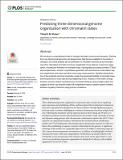Predicting three-dimensional genome organization with chromatin states
Author(s)
Qi, Yifeng; Zhang, Bin
DownloadPublished version (2.726Mb)
Terms of use
Metadata
Show full item recordAbstract
We introduce a computational model to simulate chromatin structure and dynamics. Starting from one-dimensional genomics and epigenomics data that are available for hundreds of cell types, this model enables de novo prediction of chromatin structures at five-kilo-base resolution. Simulated chromatin structures recapitulate known features of genome organization, including the formation of chromatin loops, topologically associating domains (TADs) and compartments, and are in quantitative agreement with chromosome conformation capture experiments and super-resolution microscopy measurements. Detailed characterization of the predicted structural ensemble reveals the dynamical flexibility of chromatin loops and the presence of cross-talk among neighboring TADs. Analysis of the model’s energy function uncovers distinct mechanisms for chromatin folding at various length scales and suggests a need to go beyond simple A/B compartment types to predict specific contacts between regulatory elements using polymer simulations.
Date issued
2019-06Department
Massachusetts Institute of Technology. Department of ChemistryJournal
PLOS computational biology
Publisher
Public Library of Science (PLoS)
Citation
Qi, Yifeng and Bin Zhang. “Predicting three-dimensional genome organization with chromatin states.” PLOS computational biology 15 (2019): e1007024 © 2019 The Author(s)
Version: Final published version
ISSN
1553-7358
1553-734X